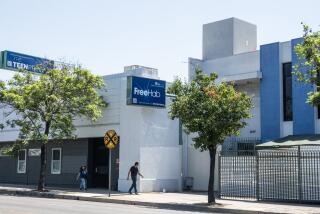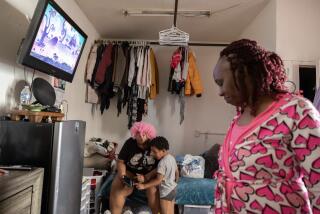A Milestone at Haven for Homeless Women
The brightly lit lobby of the Downtown Women’s Center is worlds apart from the bleak skid row street just outside the door. Birds chirp and Gladys Knight plays on the radio amid the chatter of residents and homeless women who drop by for the day.
On Monday, the center will commemorate its 20th year as a safe place for women to get off the streets for a few hours or to gain some stability in their lives by means of a permanent, albeit simple, home. The homeless woman who was the inspiration for the center will also be honored.
Founder Jill Halverson was a social worker helping alcoholic men when she met Rose, whose home was a parking lot, with two shopping carts for walls. Halverson was impressed with the dignified way Rose led her life: She had somehow managed to get a key to an outside water faucet, enabling her to take bucket baths. She carried a frying pan in one of her carts and sauteed garlic, onions and tomatoes over a fire she built.
“She’s a newspaper junkie like me--she would find yesterday’s paper and read it,” Halverson said. “She loves politics. She’s bright and articulate. She really made me understand the thin line that separates me from her.”
It wasn’t easy for Halverson to get to know Rose. “She would call me ‘that hippie woman’ because I had long hair,” she said. “But I was persistent. I would get us coffee, and we would chat. Sometimes the chat was good, sometimes it was better to leave.”
Halverson learned that there were no facilities where women like Rose could bathe, eat a good meal and get off the streets for a while. So she decided to start her own. “I wanted to provide a safe, attractive environment to show the women that their lives had value,” Halverson said.
In the days before the center opened, the downtown missions were an option for women, but only for meals. “They would have to get in line with the men, and it was pretty intimidating,” Halverson said. “The women tended to keep themselves hidden.”
She started looking for a storefront for her organization but had little luck. “I wasn’t a very attractive tenant to most,” she said. The area was being redeveloped at the time, and building owners had their pick of profit-making tenants.
Sophie Hammill owned a light-manufacturing building on South Los Angeles Street and was sympathetic to the cause. She gave Halverson six weeks of free rent. Halverson started fixing the place up with the help of volunteers. She added some donated furniture and opened the doors in mid-1978.
“The common denominator was mental illness,” Halverson said. “The hospitals closed in the early 1970s. Medications were a cheaper way to treat the symptoms, but the community care centers weren’t set up. We became a de facto mental health facility with our volunteer psychiatrists and psychiatric nurses.”
Mental illness was a factor in Rose’s life on the street. “It was hard for her to be with people she didn’t know,” Halverson said. “Sometimes she would hallucinate.”
Rose finally got off the street when the center’s 47 one-room apartments were built in 1986. She had a hard time adjusting to a bed because she had slept on the pavement for so long. She kept a shopping cart in the basement in case she couldn’t handle living indoors.
The center’s residents are mostly elderly and mentally ill women who receive General Relief or Supplemental Security Income. They cook their meals in a community kitchen and participate in art and drama classes.
Rose still lives in her apartment but is distrustful of strangers, staff members say.
Halverson has moved to New Mexico, where she works for Democratic Sen. Jeff Bingaman on housing and homeless issues.
“I always felt that I should create an organization that would not be dependent on me,” Halverson said. “I always intended to leave.”
Last November, Rose and a center staffer took the train to Albuquerque to see Halverson, the first time Rose had left Los Angeles since 1947.
“We had a fabulous time. Rose is like family to me,” Halverson said. “It’s been a privilege to know her and to have my life touched by her in a very profound way. The Women’s Center is the centerpiece of my life and I owe that to knowing her.”
More to Read
Sign up for Essential California
The most important California stories and recommendations in your inbox every morning.
You may occasionally receive promotional content from the Los Angeles Times.






